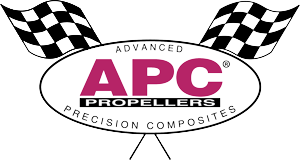Manufacturing Process Used To Develop APC Propellers
Processing
Mold halves used in injection molding machines are manufactured using computer controlled vertical milling machines which have automatic tool calibration and tool change features. Each mold half is cut with a series of cutting tools using progressively smaller tool radii and finer mesh spacing. Once started, the operations required to cut a mold half are completely automatic. Typically hand polishing of the mold cavity is not required after the milling operations are complete.
During an injection molding production run, fine adjustments may be made (if necessary) to control propeller balance. Molding machine parameters, once set, are stored electronically for subsequent use to assure consistency between propeller batches.
Larger propellers are retrieved from the injection molder with a robotic machine. The only postoperative manufacturing requirement is the drilling of the prop shaft center hole. This process is semi-automatic and utilizes a guide hole created by a feature within the mold.
Materials
The molding compound used in APC propellers is primarily a long glass fiber composite. The majority of APC propellers are made with the fiberglass composite due to its superior mechanical properties. A select number of APC propellers are made from a long carbon fiber composite, these are typically special application propellers. The carbon fiber propellers have the letter C in the part number. Due to the increased popularity of quad-copter racing, some smaller APC propellers are now made with a Polycarbonate material. These DURABLE propellers are specifically designed for quad racing and freestyle. They are incredibly resistant to breakage and have the letters BD at the beginning of the part number.
The long glass and carbon fiber composites are manufactured using a pultrusion process. This method causes the "fibers" to be oriented axially in 1/2 inch long pellets. This long fiber compound allows a higher fiber (60% fiberglass) to resin (nylon binder) density than short or chopped fiber compounds. Reground material is never used for APC propellers. Viscous (skinning) effects during injection molding cause these long fibers to remain dominantly oriented in the propeller span-wise axis. This provides substantially higher strength and stiffness compared to more conventional processes which use short or chopped fibers. While both more costly and difficult to manufacture, the performance advantages of long fiber composites are substantial, as shown on the following table.
|
Mechanical Property |
Unreinforced |
Glass Filled |
APC Long |
|
Tensile Strength |
11.0 KSI |
18.0 KSI |
33.0 KSI |
|
Tensile Elongation |
> 10 % |
3 to 4 % |
1 to 2 % |
|
Flexural Strength |
7.0 KSI |
29.0 KSI |
52.0 KSI |
|
Flexural Modulus |
0.41 MSI |
1.3 MSI |
3.1 MSI |
The long fiber composite material is both stiffer and stronger than standard glass filled nylon. The additional stiffness is beneficial to the control of vibration resonance response. The natural frequencies of the propeller must be kept high enough to preclude excitation from engine torsional vibration and aero-elastic flutter. The higher strength allows the use of (relatively) thinner cross-sections, beneficial to weight and aerodynamic efficiency.




